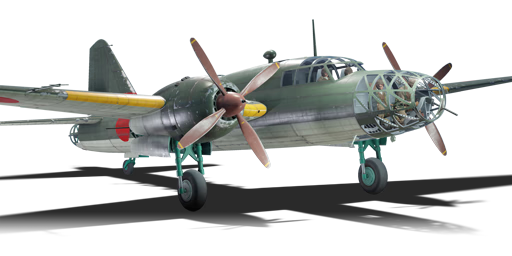




The Ki-67-I otsu, designated as Type 4 Heavy Bomber Model 1B (四式重爆撃機甲), was the later main production variant of the Ki-67 with enhanced rear defensive firepower, which was designed to replace the Ki-49 and to be suitable for possible operations over the Manchurian-Siberia border. It was designed to be one of the most survivable and damage-resistant Japanese aircraft of the war, with self-sealing fuel tanks, armour and it was also highly manoeuvrable and capable of dive-bombing attacks. It entered service in October 1944 and was used in various roles, including conventional bombing and anti-shipping. With the Ki-67 being a very capable medium bomber platform, it was remodeled and modified for other special purposes, with projects ranging from simple bomb-role upgrades, interceptor (Ki-109), bomber escort, etc.. However, due to Allied bombing raids and production delays, only 767 Ki-67s were built before the end of the war.
Introduced in Update 1.67 "Assault", the Ki-67 otsu excels in many roles in which other Japanese bombers fail to live up to. This is one of the most formidable medium bombers out there, as it is fast, has great defensive capabilities, can mount a wide array of bombs and torpedoes, and has really good survivability. The Ki-67 otsu has a wide variety of roles, but its main role is actually a frontline bomber, as it can destroy pillboxes and other high value ground units. Its payload isn't optimal to target bases alone, so it is advisable to target individual ground targets. The Ki-67 otsu differs from the previous model, the Ki-67 Ko, in rear of the aircraft. The Ki-67 otsu has a double tail gun configuration, giving it more defensive capabilities.
flaps
flaps
flaps
brake
| Belt | Belt filling | Armor penetration (mm) at a distance: | |||||
|---|---|---|---|---|---|---|---|
| 10 m | 100 m | 500 m | 1000 m | 1500 m | 2000 m | ||
| HEF-I/P/AP-T | 26 | 24 | 16 | 9 | 6 | 3 | |
| AP-T/AP-T/HEF-I | 26 | 24 | 16 | 9 | 6 | 3 | |
| HEF-I/HEF-I/AP-T | 26 | 24 | 16 | 9 | 6 | 3 | |
| Belt | Belt filling | Armor penetration (mm) at a distance: | |||||
|---|---|---|---|---|---|---|---|
| 10 m | 100 m | 500 m | 1000 m | 1500 m | 2000 m | ||
| AP-T/AP/HEF-I | 21 | 19 | 13 | 7 | 4 | 3 | |
| AP-T/AP/AP-T | 21 | 19 | 13 | 7 | 4 | 3 | |
| AP-T/HEF-I/HEF-I/HEF-I | 21 | 19 | 13 | 7 | 4 | 3 | |
| Belt | Belt filling | Armor penetration (mm) at a distance: | |||||
|---|---|---|---|---|---|---|---|
| 10 m | 100 m | 500 m | 1000 m | 1500 m | 2000 m | ||
| AP-T/AP/HEF-I | 21 | 19 | 13 | 7 | 4 | 3 | |
| AP-T/AP/AP-T | 21 | 19 | 13 | 7 | 4 | 3 | |
| AP-T/HEF-I/HEF-I/HEF-I | 21 | 19 | 13 | 7 | 4 | 3 | |












Flight performance | |
|---|---|
Survivability |
|---|
Weaponry | ||
|---|---|---|